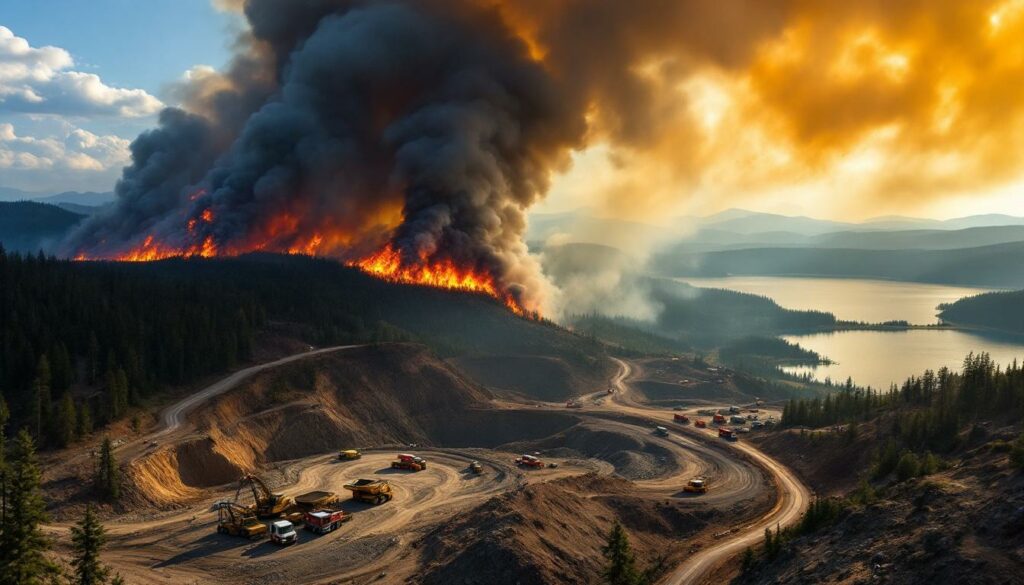Canadian Wildfires Force Mining Operations to Halt: Industry Impact Analysis
As wildfires rage across western Canada, mining companies are being forced to suspend operations, highlighting the vulnerability of resource extraction industries to extreme weather events. These disruptions come amid unusually hot and dry conditions creating perfect conditions for rapidly spreading fires, affecting not only mining but also oil and gas production across multiple provinces.
Major Mining Companies Affected by Wildfires
Several key players in Canada's mining sector have had to take emergency measures:
- Hudbay Minerals: Suspended operations in Snow Lake, Manitoba
- SSR Mining: Halted activities at Seabee operations in northern Saskatchewan
- Cenovus Energy: Scaled back non-essential workers at Foster Creek facility in Alberta
Rob Carter, Hudbay's Senior VP for Canadian operations, stated: "We will continue to monitor the situation, ensuring a safe return to full operations as soon as it is advisable" (Mining Weekly, June 5, 2025).
Hudbay Minerals' Response to Wildfire Threat
Hudbay Minerals has temporarily suspended its operations in Snow Lake, Manitoba, due to encroaching wildfires that have triggered a state of emergency in the province. This shutdown affects a significant portion of the company's copper production capacity.
Production Impact Assessment
The operational pause at Snow Lake creates measurable production impacts:
- The facility produced 7.7 million pounds of copper in Q1 2025
- This represents 7.2% of Hudbay's total copper production
- Both Flin Flon and Snow Lake exploration activities have been paused
- Company officials report infrastructure and facilities currently face low risk of damage
As of June 5, 2025, Hudbay has confirmed that while operations are suspended, their facilities are not in immediate danger. The company has implemented its emergency response plan, including the evacuation of non-essential personnel.
Evacuation Measures and Safety Protocols
The temporary shutdown follows a precautionary evacuation notice issued by local authorities for the town of Snow Lake on Tuesday, June 3, 2025. This proactive measure aims to protect residents and workers as fire mitigation efforts continue throughout the region.
Safety Note: Mining companies typically prioritize employee safety above production targets during natural disasters, following established modern mine planning protocols for evacuation and site security.
SSR Mining's Operational Response
SSR Mining has implemented similar precautionary measures by temporarily suspending operations at its Seabee gold operation in northern Saskatchewan. Unlike Hudbay's situation, SSR Mining's decision was primarily driven by power interruptions caused by forest fires approximately 15 kilometers north of the facility.
Current Status and Market Impact
The market has reacted to these operational disruptions:
- SSR Mining's stock fell 2.9% to C$16.75 following the announcement
- The company maintains that fires do not currently pose an immediate threat to site infrastructure
- A team remains on-site to monitor the situation and maintain essential services
- Power restoration timeline remains uncertain, dependent on wildfire containment
"Our primary concern is the safety of our employees and contractors," an SSR Mining spokesperson noted in their official statement (Mining Weekly, June 5, 2025).
Environmental Conditions Driving the Wildfire Crisis
The 2025 Canadian wildfire season has proven exceptionally severe, with conditions creating perfect fire-spreading environments across western provinces.
Key Environmental Factors
Several elements have combined to create this crisis:
- Unusually hot temperatures across Manitoba, Saskatchewan and Alberta
- Extended drought conditions creating tinder-dry forest conditions
- Low humidity levels accelerating fire spread
- Strong, unpredictable winds pushing flames in multiple directions
- Limited rainfall forecast for the coming weeks
These fires have already consumed hundreds of thousands of hectares of forest and bushland, with Manitoba declaring a state of emergency and thousands urged to evacuate from affected areas.
Impact Beyond Mining: Other Industries Affected
The wildfires are disrupting multiple resource-based industries critical to Canada's economy, particularly in the energy sector.
Oil and Gas Production Disruptions
Energy producers are taking significant precautions:
- Cenovus Energy has scaled back non-essential workers at its Foster Creek facility in Alberta
- Several oil sands operations are operating with reduced staff
- Power interruptions threaten continuous operations across several sectors
- Supply chain disruptions are emerging as transportation routes are affected
Industry analysts estimate potential production losses could reach into the thousands of barrels per day if the situation persists, though exact figures remain difficult to calculate as companies implement various levels of operational reductions.
Wildfire Risk Management in the Mining Sector
Mining companies operating in wildfire-prone regions typically implement comprehensive risk management strategies to protect their assets, employees, and surrounding communities.
Industry Standard Mitigation Approaches
Best practices include:
- Continuous monitoring of weather conditions and fire risk levels
- Regular coordination with local authorities on evacuation protocols
- Maintenance of firebreaks and vegetation clearing around critical infrastructure
- Development of business continuity plans for temporary shutdowns
- Investment in backup power systems and emergency response capabilities
"The mining industry has become increasingly sophisticated in its approach to wildfire risk," notes the Mining Association of Canada. "Companies now incorporate climate adaptation strategies into their industry evolution trends" (Mining Weekly, June 5, 2025).
Timeline for Operational Resumption
The timeline for resuming normal operations remains uncertain and depends largely on when the wildfire threat subsides. Companies are maintaining close communication with local authorities and emergency management teams.
Critical Factors Determining Resumption
Several key indicators will determine when operations can safely restart:
- Containment status of nearby fires (currently at low containment levels)
- Weather forecasts and anticipated precipitation events
- Restoration of power infrastructure in affected regions
- All-clear signals from local emergency management officials
- Completion of safety inspections at affected facilities
Both Hudbay and SSR Mining have indicated they will prioritize safety over rushing to resume production, with comprehensive facility assessments planned before restarting.
Economic Implications of Mining Disruptions
While temporary in nature, these operational disruptions could have measurable effects on production volumes, quarterly financial results, and potentially commodity prices if extended significantly.
Potential Economic Consequences
The financial impact extends beyond immediate production losses:
- Reduced production volumes for Q2 2025 financial reporting
- Supply chain disruptions for downstream metal processors
- Increased operational costs related to shutdown and restart procedures
- Insurance claims for business interruption (typically with waiting periods)
- Potential commodity price impacts if disruptions become widespread or prolonged
Investor Note: While localized disruptions rarely impact global commodity prices significantly, widespread or prolonged shutdowns across multiple operations could potentially create supply constraints that influence market pricing.
Climate Change and Mining Industry Vulnerability
The increasing frequency and severity of wildfires across Canada raises important questions about the relationship between climate change and operational risks for resource extraction industries.
Climate Considerations for Future Operations
Forward-thinking mining companies are adapting to new realities:
- Enhanced risk modeling incorporating climate change projections
- Infrastructure hardening against extreme weather events
- More robust backup systems for critical operations
- Strategic diversification of operational locations
- Investment in remote monitoring technology to reduce on-site personnel during emergencies
Industry experts suggest that companies incorporating climate adaptation into their operational planning may gain competitive advantages through improved resilience and reduced downtime during extreme weather events.
Mining Industry Wildfire Response: Frequently Asked Questions
How common are wildfire-related disruptions to Canadian mining operations?
While seasonal wildfires have historically affected Canadian mining operations, the scale and impact of recent fire seasons represent a significant increase in frequency and severity. Mining companies operating in forested regions now factor wildfire risk into their operational planning as a recurring seasonal threat rather than an exceptional event.
Do mining companies typically have insurance for wildfire-related disruptions?
Most major mining companies maintain business interruption insurance that may cover some losses from temporary shutdowns due to natural disasters, including wildfires. However, coverage details vary significantly between policies, with deductibles, waiting periods, and exclusions potentially limiting compensation for short-term disruptions.
How do mining companies protect their workers during wildfire threats?
Mining operations typically implement tiered response protocols based on fire proximity:
- Alert phase: Increased monitoring and preparation
- Reduction phase: Non-essential personnel evacuated
- Suspension phase: Operations halted with skeleton crew remaining
- Full evacuation: Complete site shutdown with security monitoring only
Employee safety remains the primary consideration in these decisions, with companies often erring on the side of caution given the unpredictable nature of wildfire behavior.
Could these disruptions affect global metal prices?
While localized disruptions rarely impact global commodity prices significantly, the cumulative effect of multiple operations being affected simultaneously could create temporary supply constraints. Copper markets in particular may experience short-term pricing sensitivity if Hudbay's production pause extends beyond a few weeks, as seen in similar operational halt case studies.
Are mining companies adapting their operations for increasing wildfire risks?
Leading mining companies are incorporating climate adaptation strategies into their operational planning, including:
- Improved fire detection systems and early warning networks
- Enhanced firebreaks and vegetation management around critical infrastructure
- Backup power generation and water supply systems
- More robust evacuation protocols and employee training
- Increased collaboration with local emergency services
These adaptations represent a growing recognition that wildfire risks are likely to persist or increase in coming years due to changing climate patterns.
Looking Forward: Industry Resilience and Adaptation
As Canadian miners pause operations due to wildfires, the industry as a whole is developing more sophisticated approaches to climate resilience. The temporary shutdowns at Hudbay and SSR Mining highlight both the vulnerability of mining operations to extreme weather events and the industry's growing capacity to respond effectively to protect personnel and assets.
Industry Perspective: "The resource sector is increasingly treating climate adaptation not as an optional sustainability initiative but as a core business requirement," notes the Mining Association of Canada. "Companies that fail to adapt risk significant operational disruptions and financial losses."
For investors, communities, and industry stakeholders, the current wildfire crisis serves as a reminder of the complex interplay between data-driven operations and reclamation innovation in Canada's mining sector. According to reports from CTV News, the disruption has already significantly impacted local communities dependent on these operations.
Disclaimer
This article contains information about ongoing wildfire events and their impact on mining operations. Situation details may change rapidly as fire conditions evolve. All operational status information is based on company statements as of June 5, 2025. Investors should consult official Hudbay statements for the most current information regarding operational status and financial implications.
Want to Spot the Next Major ASX Discovery Before the Market Does?
Stay ahead of the investment curve with Discovery Alert's proprietary Discovery IQ model, which provides real-time notifications of significant mineral discoveries on the ASX as they're announced. Visit our discoveries page to see why major mineral discoveries like those from De Grey Mining have delivered exceptional returns to early investors.




